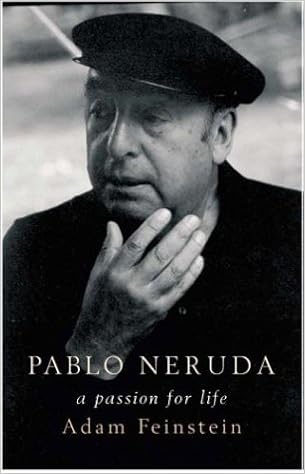 Let's talk Latin America
Let's talk Latin America
 Let's talk Latin America
Let's talk Latin America
Edie Essex Barrett interviewed Adam Feinstein, the official biographer of Pablo Neruda: Chilean poet, diplomat, politician and Nobel Prize for Literature winner in 1971.
A passion for Neruda has led to a lifelong, fascinating and diverse career for the biographer, Adam Feinstein. His love for Neruda’s work “started in the late-1990s and never stopped,” he told me. He first discovered the writer reading his prose and memoirs in French whilst studying in Paris. By 2004 he had published the first official biography of Pablo Neruda, which marked the centenary of Neruda’s birth. His book was very well-received, with some updated editions following in 2013 after recent curiosities surrounding the causes of Neruda’s death.
Telling me more about how he progressed to become the first biographer, he said, “[Memoirs by Pablo Neruda] was a wonderful book. Neruda knew everyone in the 20th century. He also took part in many important events — saving Spanish refugees in 1939 from France to Chile on the SS Winnipeg boat; escaping the conservatives on horseback — his actions were just as wonderful as his words.” A while before beginning the book, Adam had read bits of Neruda’s poetry, but became a journalist before returning to Neruda in the late 1990s.
At this point, he began to reread all of his poetry, labelling Neruda as “the greatest poet of the 20th century”. He thought “there must be a biography of this guy”, but the only thing he could find was a translated book by politician and friend of Neruda’s, Volodia Teitelboim. This biography was apparently incomplete because “it left out crucial elements of Neruda’s life”, namely those negative moments, such as Neruda abandoning his sick daughter and his first wife. It also failed to mention Stalinism — “none of these were selling points for Neruda”, but they were topics that “needed to be tackled”. Adam argues that Teitelboim was too close to Neruda to produce a good biography – “it was more of a hagiography”. Although it should be kept in mind that Neruda “saved the lives of many people and was a loyal friend to many”, this style is typically reserved for biographing a saint.
In the end, Adam approached his agent proposing to write a book about Neruda. He wanted to dive into the true story of Neruda, “with the blacks, whites and nuances of his life”. They liked the idea, and Adam was able to travel around the world to the different places Neruda lived, gathering stories from all the different people who came in and out of his life. He spoke to those who housed Neruda when he was in hiding, passengers on the SS Winnipeg – some of which are now great artists too; “You cannot disentangle Neruda’s life from his works.”
Adam’s personal favourite of Neruda’s writings is Estravagario, published in 1958. “Neruda wrote this book when he was having doubts about a lot of things to do with himself and his political stance”, Adam informs. As a Stalinist, the events following the crushing of Hungary by the Soviets among others “really knocked [Neruda] down”. Although personal, Estravagario is also very funny. Adam mentioned that there is a “very humble and beautiful last section” – ‘Testamento de otoño‘, a love poem written for his third wife who passed away. Adam also highlights the calibre of Neruda’s posthumous works: “a lot of [it] is a return to more personal poetry; moving and touching, and little known in the English-speaking world”.
In terms of his least favourite, Adam named the collection Las uvas y el viento; “It has some beautiful poems, but in my view it’s tainted by socialist realism.” Adam tells me that Neruda spent 3 years juggling his life between his mistress and his second wife, which is revealed in the love poems of this collection. However, for Adam, this collection “is too overtly political.” He says that “people make a false schism between the love and the political in [Neruda’s] poetry, but this one is heavily weighted towards his political stance, which damages the book.” Interestingly, Neruda considered this as one of his best works. “He was wrong,” Adam asserts.
Another of Adam’s lesser favourites is Las manos del día, published in 1968. “He whinges a lot about the fact that he hasn’t done anything with his hands”, such as how he never baked a loaf of bread. “Oh, c’mon,” Adam voiced, “Neruda is the equivalent of the 20th century Lord Byron!”
Since penning Neruda’s official biography, Adam has also been asked to translate a lot of Neruda’s work, including 10 extracts from Canto General in 2013, in which “beautiful illustrations” by Brazilian illustrator, Ana Maria Pacheco, can be found. He regularly travels to give talks on Neruda, many recently being related to Pablo Larraín’s film Neruda, which came out in 2016. “I’m still discovering new things all the time: poems, letters, bits of his life are clarifying themselves”, Adam told me. “It’s a never-ending and exhilarating profession to track down bits of Neruda documentation.”
More recently, Adam wrote an article for the Guardian about a recent discovery by a team of forensics. It is now ambiguous as to whether Neruda really did die of cancer in 1973, as some suspicious bacteria has been found in his remains. Neruda died just 12 days after Pinochet’s coup in 1973. Neruda’s life was inextricably tied to politics, and Adam stresses that “you can’t appreciate [Neruda’s] poetry to the full without knowing about his life”. He acknowledges that it’s possible to respond to the music of the language in the poems, but “it enhances things to know about his life.”

To follow more of Adam’s work, follow him on Twitter @AdamFeinst. His book can be purchased on Amazon.
Header image- Fundación Pablo Neruda, image above- Amazon books.